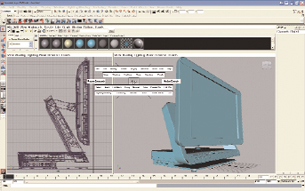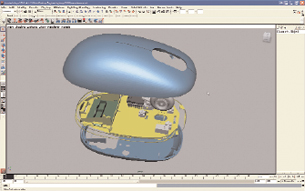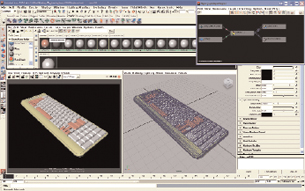Latest News
May 1, 2008
By Mark Clarkson
 A prototype computer system, imported into Maya from a STEP file. |
Autodesk Maya 2008 is not an MCAD program. In fact, Maya is perhaps the least CAD-like of Autodesk’s many 3D offerings. But Maya has a lot to offer in terms of design and rendering, especially if you’d like to take your work to the next level with complex animations, real-world materials and lighting, and even animation or special effects.
Maya 2008 introduces a host of general tweaks and improvements from faster rendering to general viewport enhancements, such as high-quality rendering with preview for complex, layered shaders. There have also been some significant improvements in the polygon modeling workflow. Nothing earth shattering; just a good, solid update.
A Familiar Interface
Maya, like AliasStudio, (see “AliasStudio 2008: Designer Software,” August 2007 DE) is produced by Alias Systems, now owned by Autodesk, and you can feel the kinship.
If you’re familiar with AliasStudio, you’ll feel right at home in Maya’s interface. There are “shelves” for all your different tools. There’s a shelf for polygon tools, a shelf for rendering tools, and so forth. You can customize the shelves and create your own.
Pressing the spacebar brings up a customizable menu called the HotBox that allows you to quickly make selections, alter settings, and so forth, without moving up to the main menu.
One new feature is the ViewCube, which sits in one corner of your viewport. Click and drag it to rotate the view; click on the face labeled TOP to switch to top view; and so forth. The cube’s clear perspective shows you exactly how your view is oriented. It is straightforward and friendly; kudos to the developers. I’d like to see more tools and touches like this.
Maya’s customizable interface is streamlined, especially considering the application’s complexity, but I’d like more feedback. This is an area where MCAD programs have spoiled me. I had the same complaints about AliasStudio: the cursor, for example, is almost always the same shape — an arrow and box — no matter what your task.
 The Maya 2008 workspace is streamlined, especially considering the application’s complexity. |
Maya also usurps some of Windows’ standard navigation hotkeys (e.g., Alt+F for the File menu), which is a bit annoying. And, for some reason, Maya’s tool tips simply won’t pop up for me.
Rendering
Maya’s material tools allow you to construct textures and surfaces of almost stupefying complexity.
To render the final results, Maya provides you with three rendering engines out of the box: software, hardware, and the mental ray tracer. Mental ray is a physically accurate renderer, using simulated photons, and is capable of strikingly realistic output.
Speaking of photons, Maya 2008 supports high dynamic range imaging (HDRI) lighting, which uses a high dynamic range photograph, usually a panorama, to provide all the lighting in your scene. Wrap your scene or model in a panorama of an office building interior — or the Sistine chapel — and the lighting, shadows, and reflections will render accurately and realistically. This is a really easy way to create a pleasing, true-to-life lighting setup.
 The window at top right shows Maya’s node-based interface, visually displaying the lights andshaders that affect one of the materials in the scene. |
Modeling
Maya 2008 has more modeling tools than you can shake a CPU at, and multicore support for modeling to boot.
You create objects with some combination of three sets of tools: polygon, NURBS, and subdivision modeling.
Maya has the full complement of polygon modeling and editing tools, and I was really comfortable in Maya’s polygon environment. New selection tools make it even easier to work with polygon edges.
Maya also supports NURBS modeling. NURBS surfaces are derived from curves (non-uniform rational B-splines, in fact) that can be extruded, lofted, revolved, trimmed, split apart, or stitched together. If you’re an MCAD user, you’ll probably feel most comfortable in Maya’s NURBS environment.
Then there’s my true love: subdivision modeling. My favorite way of sketching in 3D is to start with a simple box or sphere or cylinder and start pushing and pulling and beveling and slicing to see where it takes me — the “lump of clay” approach, if you will. MCAD programs are generally sadly deficient in this area, but Maya excels here.
Think of Subdivisions as a sort of hybrid between NURBS and Polygons, using the polygon mesh as a control cage to define an underlying smooth surface. A subdivided cube, for example, becomes a sphere, with each vertex in the original polygon cube controlling the sphere’s shape. You can add detail only where you need it, by further subdividing your mesh in select areas.
Maya will also import MCAD data from a variety of formats, including SolidWorks, STEP, IGES, and DWG/DXF. Pro/ENGINEER support is available as an option.
As you work, Maya keeps a construction history of all your operations. You can edit and rearrange these history nodes; alter the curve that defines a revolved surface, for example, and the surface automatically updates. We MCAD users, of course, have come to expect this.
MEL and Python
If you like to play around under the hood, Maya has its own embedded scripting language called MEL. MEL can do pretty much everything you can do through the interface, as well as a few things you can’t. It comes in quite handy for speeding up repetitive tasks.
MEL is similar in structure to Perl. Maya also supports scripting in Python, if that’s your preference.
Special effects
I reviewed Maya Unlimited, which includes simulation tools including fluid effects (water, fire, smoke, etc.), cloth, fur, hair, and motion tracking. Not features that most engineers will find essential, granted, but handy if you’d like to add grass, clouds, fire, smoke, and so forth to your renders and animations.
Maya’s physics simulation is growing increasingly powerful. nCloth is more than a simple cloth simulation. You can use it to simulate deformable plastics and metals, or even build a hot air balloon, inflate it, and watch it rise into the air.
If you don’t need any fancy simulation paraphernalia, Maya Complete will do you just fine.
Import Fix string $select[] = `ls “transform*”`; |
Maya — available for 32- and 64-bit Windows XP, 32-bit Mac OS X (Intel and PowerPC) and 32- and 64-bit Linux — is deficient in straight-up MCAD capabilities, especially in terms of layout. Only with this release does Maya give you the ability to position objects along a curve, for instance. But as I said at the beginning, this isn’t an MCAD program, it’s a design and rendering tool.
If you’d like to give it a test run, you can download the Personal Learning Edition — fully functional but with a proprietary “learning” file format and watermarked renders. Visit usa.autodesk.com, find Maya under Products, and you’ll see the Personal Learning Edition download link front and center.
Contributing Editor Mark Clarkson, a.k.a. “the Wichita By-Lineman,” has been writing about all manner of computer stuff for years. An expert in computer animation and graphics, his newest book is “Photoshop Elements by Example.” Visit him on the Web at markclarkson.com or send e-mail about this article c/o [email protected].
Info
Maya 2008
Autodesk, Inc.
San Rafael, CA
usa.autodesk.com
>Price: Maya 2008 Complete (standalone), $1,999.
Maya 2008 Unlimited (standalone), $4,995.
International pricing may vary.
>Online link for free download version:
usa.autodesk.com/adsk/servlet/mform?siteID=123112&id=9432085
Subscribe to our FREE magazine, FREE email newsletters or both!
Latest News
About the Author
Mark ClarksonContributing Editor Mark Clarkson is Digital Engineering’s expert in visualization, computer animation, and graphics. His newest book is Photoshop Elements by Example. Visit him on the web at MarkClarkson.com or send e-mail about this article to [email protected].
Follow DE





